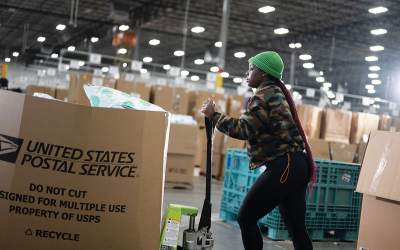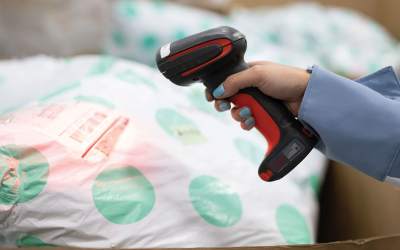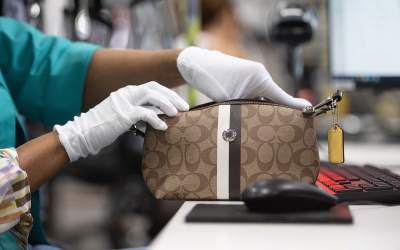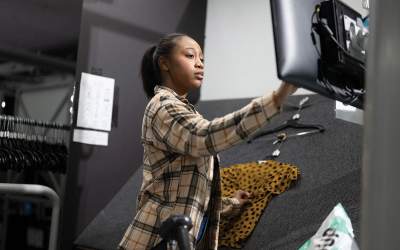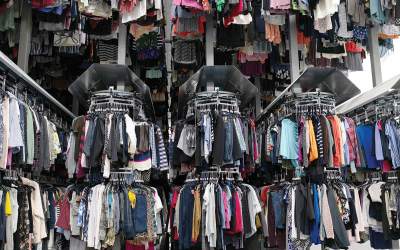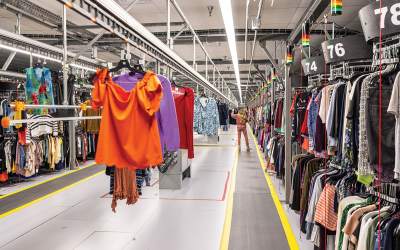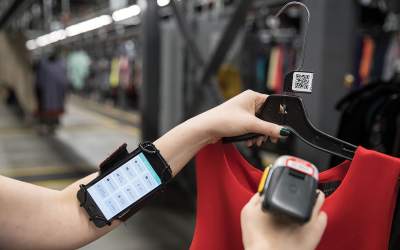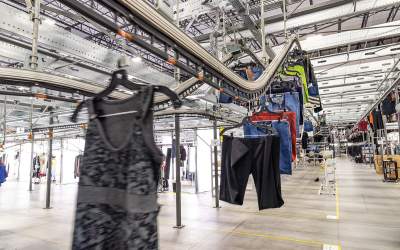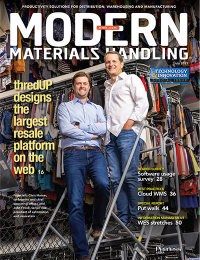thredUP designs the largest resale platform on the web
The online retailer’s challenge was to design a system to quickly get new garments processed, ready for sale and out the door as efficiently as possible.
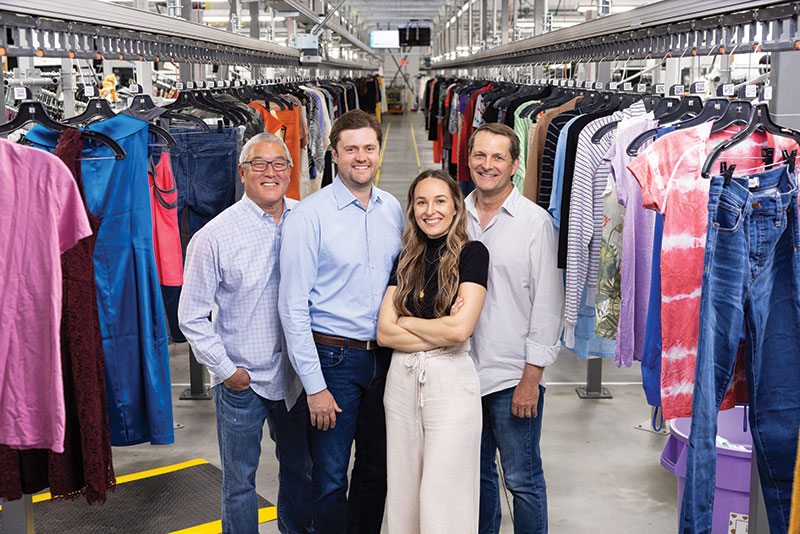
We live in an era of disruption. New business models continue to upend the conventional. More often than not, those business models lead to new distribution models and networks. Such was the case for thredUP, a marketplace bringing next generation technologies like machine learning and automated goods-to-person storage and order fulfillment to a channel we normally associate with small, neighborhood retailers and non-profits: The thrift shop.
Back in 2016, thredUP came to a realization: The bottleneck to increased sales was its distribution processes. If it could redesign its largely manual handling processes from receipt to shipping, it could process more garments and increase sales.
“We needed to increase our inventory capacity to meet growing customer demand,” notes John Friedl, senior vice president of automation and innovation. “In the past, that meant building new distribution centers, which was time consuming and costly. Instead, we began considering alternatives for increasing storage capacity within the existing facilities.” At that time, the network included four manual DCs.
Take an closer look at the layout inside the thredUp facilty: Hanging it up at thredUP
The question was: What technologies could cost effectively make that happen? The answer was a new design developed in-house that includes a multi-level storage and pick module, including the ground level, that uses an automated garment-on-hanger conveyor system and horizontal storage carousels. It’s not unlike what you might see in your neighborhood dry cleaner, but on steroids. During the proof-of-concept stage, thredUP’s industrial engineering team worked closely with FlexSim on a detailed process simulation model.
Each level of the patented design consists of an overhead delivery and takeaway conveyor system, multiple buffer locations and storage carousels that reach a height of about 6 feet. This way, an associate can reach any item without a ladder. Some carousels are configured to hold longer items; some have two levels stacked one on top of another for shorter items; and some have three levels for items that take up the least amount of space, such as accessories, handbags and shoes.
The results have been significant since rolling out the technology in all four of thredUP’s facilities nearly six years ago. “We currently have the capacity to hold nearly nine million unique items across the network with the capacity to hold an additional 7.5 million in the future,” says chief operating officer and co-founder Chris Homer.
Inventory capacity has increased by more than a factor of three, pick and putaway efficiency has increased six-fold and operator efficiency at the packout stations has more than doubled. Friedl notes that the company realized a positive ROI in less than 24 months on the first system. With a nearly 600,000-square-foot distribution center in Lancaster, Texas, now online—the company’s largest—thredUP has the capacity to process more than 100,000 unique items per day across the network.
“The majority of the hardware solutions available in the garment-on-hanger space are focused on storage and distribution of similar types of garments, such as manufacturers and industrial laundries,” says Keith Hiyama, vice president of automation. “We needed to design a system that could efficiently store and retrieve millions of unique items cost effectively using our own warehouse management system.”
thredUP looks to offer new service models
thredUP allows consumers to buy and sell secondhand and has also been enabling brands and retailers to offer customizable, scalable resale programs to their customers through its Resale-as-a-Service (RaaS) offering since 2019.
thredUP’s Resale-as-a-Service was born out of the company’s New Venture arm as a way to unlock growth by leveraging thredUP’s existing marketplace infrastructure. Today, thredUP works with more than 40 brand clients through RaaS, including J. Crew, Tommy Hilfiger and Madewell.
Now, the company is planning to open up its network even further and leverage its proprietary software and systems to provide additional services—from returns processing, to pricing for resale, to online fulfillment.
“The processing capabilities, technology, and data science expertise we already have in place that underpin our operating platform lend themselves well to a host of other services for brands and retailers,” said John Friedl, senior vice president of automation and innovation.
Opening up what were previously proprietary networks is part of a nascent but emerging trend in the retail industry, as organizations look for ways to leverage their networks and expertise with other companies with similar distribution requirements.
Some call it co-opetition, where retailers who otherwise compete on price, quality and service look for ways to cooperate in their supply chains. Modern has previously reported on how American Eagle and Gap Inc. are offering e-fulfillment services to small to mid-sized specialty retailers.
“Opening up our network to leverage our experience in processing returns and reselling apparel allows us to further leverage the investment we’ve made in capacity and apply what we’ve built for other companies,” Friedl said. “Soon, in addition to a person sending us garments, it’ll be a company.”
Sustainability also plays a critical role. The more secondhand items thredUP sells, the greater the environmental impact.
“One of thredUP’s primary goals is to reduce the fashion industry’s impact by extending the life cycle of apparel and keeping as many items as possible in closets and out of landfill,” says Friedl. “The climate crisis is more urgent than ever, and this is driving a new wave of growth in resale.”
There’s another important differentiating aspect to thredUP’s operations: Most supply chains are designed around order fulfillment and forward logistics; reverse logistics is often an after-thought since the volumes of returns aren’t nearly as great as those going out.
Reverse logistics is at the heart of thredUP’s business, as customers send millions of garments for resale to the company’s facilities every year. In essence, thredUP begins with a process similar to a return, even if it was originally purchased from someone else, making reverse logistics and returns processing a best practice (see box).
Taking on the thrift market
thredUP got its start in 2009 when the company’s co-founder and CEO James Reinhart realized he had a closet full of clothes he didn’t wear. The original concept was a site to swap men’s shirts. Over time, the concept evolved to a site focused on secondhand apparel, shoes and accessories. In the company’s words, it is “modernizing resale with technology and a mission to inspire a new generation of shoppers to think secondhand first.”
One of the things that differentiates thredUP from a typical e-commerce or retail distribution center is that the inventory is wide—with millions of individual items—but not very deep when it comes to a representation of SKUs. It’s unlikely that thredUP is going to have more than one of the same Gap shirt in six colors and five different sizes as is common in a retail store. The process is straight-forward: Customers who want to consign or donate their clothing can either request to have a branded clean out bag shipped to their home or print a label and attach it to any shippable box or bag. The items are then shipped to one of the company’s Upcycle Centers, as they refer to the distribution centers. There, thredUP does all the work to make items available for resale—from a quality inspection, to photography, to pricing.
Distribution began from a basement in San Francisco and eventually moved into a small, manual DC across the bay in Oakland. Over time, the network grew to include manual, cookie-cutter distribution centers of roughly 120,000 square feet in Mechanicsburg, Pa.; Suwanee, Ga.; Phoenix, Ariz.; and the newest building in Lancaster, Texas. As the business gained more traction, it became apparent that distribution was the bottleneck to continued growth.
“About seven years ago, as we were bringing the Duluth, Ga., facility online, we realized that the more garments and accessories we can get online, the more revenue we can generate,” says Friedl. “But we couldn’t just keep adding DCs, because it’s hard to hire the people you need and get them up to speed quickly. So, we began to ask the question: How do we increase the capacity in our existing DCs?”
At the time, thredUP’s processes were simple. Once an item was inspected and accepted it was put on a hanger with a unique QR identification code that stayed with the garment in the proprietary warehouse management system (WMS) forever. Those hangers were placed on racks that were lined up in the stockroom. The WMS would then direct order selectors through the DC. After packing, the item was placed on a conveyor and routed to one of four shipping lanes.
“It was 100% manual, and we’d have thousands of racks that we had to keep track of,” Friedl says. “I’ve worked in a half dozen startups in the past. It’s not uncommon for high growth companies to reach a point where they have to make a decision about how to scale. We simply couldn’t scale fast enough the way we were doing it.”
The first thought was to take advantage of the full cube of the warehouse with a multi-level pick module. The facility located in Mechanicsburg had a ceiling high enough to add two more levels to the storage and pick area. But that alone would still involve thousands of manual racks.
Friedl had worked on a project some years earlier involving horizontal carousels. And, thinking about how dry cleaners store and retrieve items in much the same way as thredUP, albeit at a much smaller scale, the technology appeared to have promise.
The next decision was to focus on automating putaway, sorting and order fulfillment operations because the distribution team had a solid foundation of experience and data that allowed it to more accurately predict the outcome of the new processes.
Simulation
According to Friedl, having identified technologies that could work, the engineering team came up with a design it believed was feasible. A “make-it-in-house” approach has been a hallmark at thredUP, which also developed its own warehouse management system and technology to process newly received items.
The goal of the design was to maximize the order picking efficiency of the associates. To do this, it was decided to assign a starting location for each associate on each level of the pick module. Once the pick wave was calculated and released, all of the carousels turn to the first item to be picked by each associate.
Once an item is picked, scanned and placed onto the takeaway conveyor, the associate only has to walk several feet to the next carousel, which has already been turned to the next item on the associate’s pick list.
Within each level of the pick module, carousels were one of three types: A single-level carousel is used for long items, like dresses; a double-level carousel is used for shorter items, like a top or an item folded in half; and a triple-level carousel was designated for accessories, handbags and shoes.
The floor-level pick module is made up of single- and triple-level carousels while the second and third levels are configured as double-levels. There are more than 160 carousels to a level. Because of the added density, the design increases the inventory capacity by a factor of three while reducing the number of associates needed for putaway and picking due to the reduced walking time.
Catarina Soares, manager of industrial engineering, describes one of the design challenges as finding a balance between inventory capacity and the processing power of the inbound and outbound operations. “If we had too many work cells processing incoming items, we would quickly exceed the capacity of the carousels,” she says. “Too few would cause unacceptable delays in processing incoming items and deplete inventory levels.”
The target was a system that would deliver about 400 picks per hour per operator, up from 70 to 100 picks per hour in manual facilities. “We knew we wouldn’t have trouble putting items away, but we needed to know how many people we would need on each level of the mezzanine and how long they would wait for an item,” adds Friedl. “We realized early on we were beyond spreadsheets and needed to do something else to validate the design.”
Companies still in the early stages of growth have a number of decisions to make around their supply chains, including the design of their networks and processes.
At thredUP, John Friedl, senior vice president of automation and innovation, says the goal is to keep things small, with just enough distribution centers to maximize inventory and meet customer service expectations. The strategy begins with overall logistics costs.
“We won’t put in a facility that doubles our shipping costs in and out,” he says, adding that the availability and cost of labor is another important factor.
When it comes to automation, thredUP is always looking for technologies that will enable operations to focus hiring around the organization’s core competency: inspecting, describing, photographing and posting second-hand items for sale on thredUP’s website. “That’s our value proposition,” Friedl says.
That led to the design simulation project with Flexsim. “The model allowed us to do optimization runs where we could zero in on how many people we needed on each level and how big a pick wave we can run,” Friedl says.
The first facility to go live was the Mechanicsburg location. That facility was brought up in phases over several months that continued to use manual processes while loading inventory in the carousels. “We did a lot of testing because we had three systems that had to talk to one another,” Friedl notes.
While that was going on, the company started design work on the next DC located in Phoenix. By October 2018, both Mechanicsburg and Phoenix were up and running. The third facility, located outside of Atlanta, was commissioned in 2020. The first phase of thredUP’s largest facility located in Lancaster, Texas, which has a four-level pick module and a storage capacity eventually reaching 10 million unique items, went online in late 2022.
One of the challenges was creating a new training program for associates who had never worked with automation. “We created an extensive training program so that anyone working with the carousels and conveyors would understand how the system operated,” notes Soares.
In addition to the benefits of increased inventory capacity and throughput, Friedl believes that thredUP has put in place a system that delivers a competitive advantage. Yes, a competitor could implement a carousel system, but automation alone does not deliver a competitive advantage. After all, lots of distributors are using robots like Amazon, but few can match Amazon’s performance.
“We have a database that is second to none, a pricing model that you can only develop from having processed millions of items, and now we have a logistics network that can support our business model and growth,” Friedl says.

Article Topics
FlexSim News & Resources
thredUP designs the largest resale platform on the webLatest in Materials Handling
Geek+ and System Teknik deploy PopPick solution for pharmacy group Med24.dk Beckhoff USA opens new office in Austin, Texas Manhattan Associates selects TeamViewer as partner for warehouse vision picking ASME Foundation wins grant for technical workforce development The (Not So) Secret Weapons: How Key Cabinets and Asset Management Lockers Are Changing Supply Chain Operations MODEX C-Suite Interview with Harold Vanasse: The perfect blend of automation and sustainability Consultant and industry leader John M. Hill passes on at age 86 More Materials HandlingAbout the Author
Subscribe to Materials Handling Magazine

Find out what the world's most innovative companies are doing to improve productivity in their plants and distribution centers.
Start your FREE subscription today.
April 2024 Modern Materials Handling

Latest Resources


